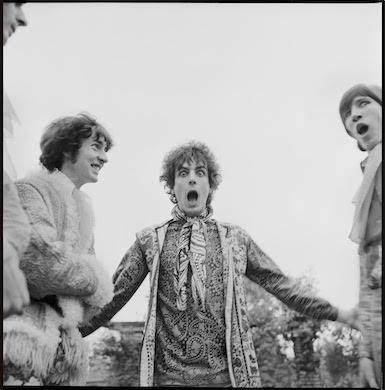Pink Floyd’s ‘Crazy Diamond’ Shines On
Few members of the audiences who have sung along with ‘Money’ or ‘Comfortably Numb’ are likely to be familiar with the name Syd Barrett, but a new documentary again places a spotlight on the ‘mad genius.’

“Syd Barrett,” Roddy Bogawa writes in the notes accompanying a new documentary, “just happened to become one of the most famous cult icons in music.” This raises a question: What is the criterion for such a designation? If “Have You Got It Yet? The Story of Syd Barrett and Pink Floyd,” the film Mr. Bogawa co-directed with the late Storm Thorgerson, is an indication, the answer is neither simple nor happy.
We all know Pink Floyd. Although it’s been some 40 years since its heyday, the band continues to roll on in one permutation or another and, sometimes, to consternating effect: Witness the recent controversies surrounding a former member, Roger Waters, and his apparent fondness for antisemitic tropes. Be that as it may, albums like “Dark Side of the Moon,” “Wish You Were Here,” and “The Wall” are staples of popular culture to this day. How many millions of albums have Pink Floyd sold? Only their accountants know for sure.
Then there’s Syd Barrett. Few members of the audiences who have sung along with “Money” or “Comfortably Numb” are likely to be familiar with the name, though Barrett did serve as the inspiration for “Shine On You Crazy Diamond,” among the group’s signature songs. As it turns out, Barrett was the veritable sine qua non of Pink Floyd, a charismatic and troubled figure who started the ball rolling but didn’t have the wherewithal to follow its trajectory.
“Have You Got It Yet?” tells the story of Roger Keith Barrett (1946-2006) through documentary footage, a range of talking heads, and some cleverly constructed fantasy segments. The latter, I’m guessing, are courtesy of Thorgerson, who was co-founder, along with Aubrey Powell, of Hipgnosis, a graphic design company that created album art for the likes of Led Zeppelin, Peter Gabriel, and, yes, Pink Floyd. The sequences featuring actors taking on the role of Barrett at different moments in his life wandering through Maxfield Parrish-like dioramas are appropriately heady in character.
How did young Barrett come to be known as Syd? Accounts vary as to whether it stemmed from the jazz musician Sid “The Beat” Barrett, the comic actor Sid James, or simply came about because the name seemed suitably prole. What is certain is that Barrett was a precocious and talented youth, exhibiting talent in painting as much as for music. The advent of the Beatles, the Rolling Stones, and Bob Dylan put paid to the notion of spending endless days in an atelier inhaling turpentine fumes. Rock ’n’ roll beckoned and, after pursuing an array of blind alleys and membership in different bands, Pink Floyd came to fruition.

The band’s first single, “Arnold Layne,” an encomium to transvestism, was banned by the BBC, but the follow-up, “See Emily Play,” proved a hit, earning Pink Floyd an invitation to perform the song on three separate occasions for the long-running television program “Top of the Pops.” Both songs were written by Barrett, as was the majority of the group’s debut album, “The Piper at the Gates of Dawn” (1967). The record is unlike anything else in Pink Floyd’s corpus, being a jaunty psychedelic foray that owes as much to Edward Lear, Lewis Carroll, and “The Wind in the Willows” as it does to Carnaby Street, Jimi Hendrix, and LSD.
LSD does figure mightily in Barrett’s life and likely exacerbated an already fragile temperament. As Pink Floyd’s fame increased, his behavior became increasingly erratic — Mr. Bogowa’s film includes a clip from “American Bandstand” in which Dick Clark does his best to converse with a near-catatonic Barrett. The band ultimately abandons their leader on the way to a gig. Barrett took a few halting stabs at a solo career, but basically lived the rest of his days in isolation, his renown as a “mad genius” increasing the further he retreated from public life.
“Have You Got It Yet?” is a cautionary tale about stardom, madness, and the excesses of a decade whose reverberations resonate today.

